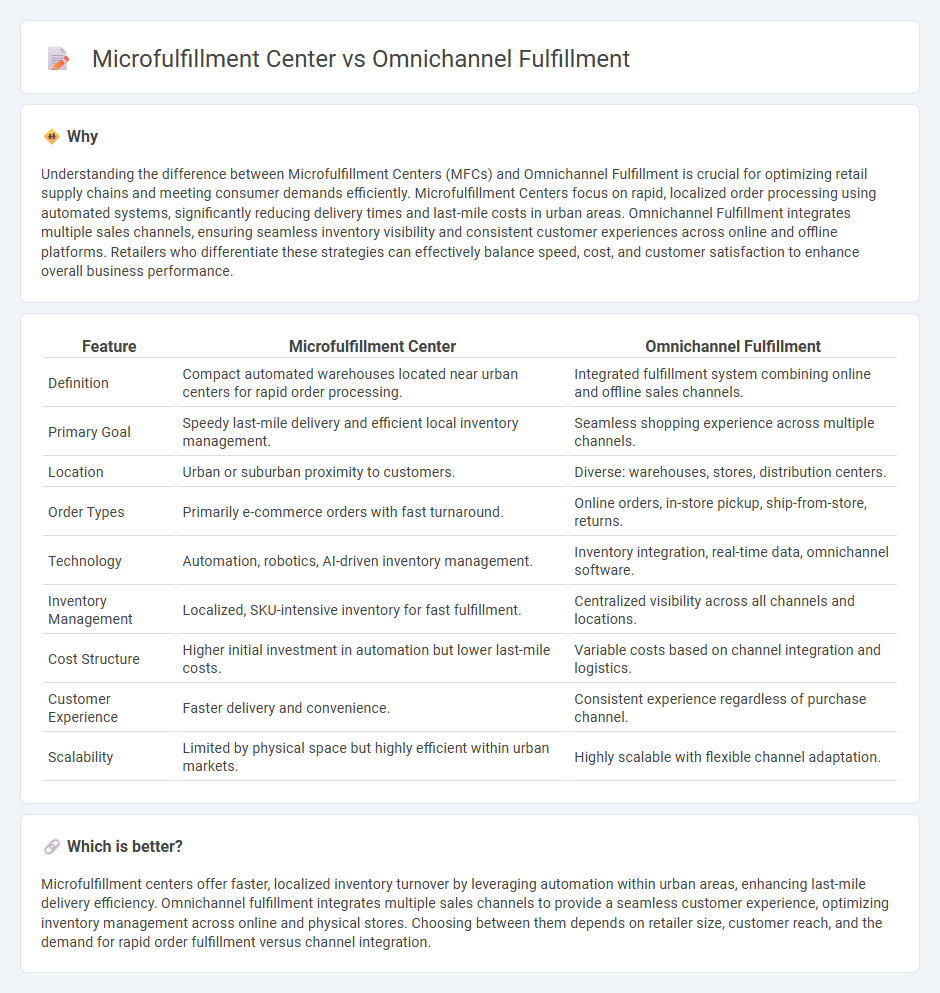
Microfulfillment centers leverage automated technology to expedite order processing and minimize last-mile delivery times within urban retail environments. Omnichannel fulfillment integrates multiple sales channels, ensuring seamless inventory visibility and flexible order fulfillment through stores, warehouses, and direct shipping. Discover how these strategies optimize retail efficiency and customer satisfaction.
Why it is important
Understanding the difference between Microfulfillment Centers (MFCs) and Omnichannel Fulfillment is crucial for optimizing retail supply chains and meeting consumer demands efficiently. Microfulfillment Centers focus on rapid, localized order processing using automated systems, significantly reducing delivery times and last-mile costs in urban areas. Omnichannel Fulfillment integrates multiple sales channels, ensuring seamless inventory visibility and consistent customer experiences across online and offline platforms. Retailers who differentiate these strategies can effectively balance speed, cost, and customer satisfaction to enhance overall business performance.
Comparison Table
| Feature | Microfulfillment Center | Omnichannel Fulfillment |
|---|---|---|
| Definition | Compact automated warehouses located near urban centers for rapid order processing. | Integrated fulfillment system combining online and offline sales channels. |
| Primary Goal | Speedy last-mile delivery and efficient local inventory management. | Seamless shopping experience across multiple channels. |
| Location | Urban or suburban proximity to customers. | Diverse: warehouses, stores, distribution centers. |
| Order Types | Primarily e-commerce orders with fast turnaround. | Online orders, in-store pickup, ship-from-store, returns. |
| Technology | Automation, robotics, AI-driven inventory management. | Inventory integration, real-time data, omnichannel software. |
| Inventory Management | Localized, SKU-intensive inventory for fast fulfillment. | Centralized visibility across all channels and locations. |
| Cost Structure | Higher initial investment in automation but lower last-mile costs. | Variable costs based on channel integration and logistics. |
| Customer Experience | Faster delivery and convenience. | Consistent experience regardless of purchase channel. |
| Scalability | Limited by physical space but highly efficient within urban markets. | Highly scalable with flexible channel adaptation. |
Which is better?
Microfulfillment centers offer faster, localized inventory turnover by leveraging automation within urban areas, enhancing last-mile delivery efficiency. Omnichannel fulfillment integrates multiple sales channels to provide a seamless customer experience, optimizing inventory management across online and physical stores. Choosing between them depends on retailer size, customer reach, and the demand for rapid order fulfillment versus channel integration.
Connection
Microfulfillment centers enhance omnichannel fulfillment by enabling rapid, localized order processing that supports both online and in-store sales channels. These compact, automated facilities reduce delivery times and improve inventory accuracy, facilitating seamless customer experiences across multiple touchpoints. Integrating microfulfillment centers into omnichannel strategies optimizes supply chain efficiency and boosts retail agility.
Key Terms
Inventory Integration
Omnichannel fulfillment integrates inventory across multiple sales channels, providing real-time visibility and seamless order management to enhance customer experience and reduce stockouts. Microfulfillment centers focus on hyper-localized inventory storage and rapid order processing, optimizing last-mile delivery but often requiring advanced inventory synchronization with larger systems. Explore how these approaches transform supply chain efficiency through strategic inventory integration.
Last-Mile Delivery
Omnichannel fulfillment integrates multiple sales channels to streamline last-mile delivery by leveraging physical stores, warehouses, and distribution centers for faster, more flexible customer service. Microfulfillment centers specialize in high-speed, automated order processing near urban areas to reduce delivery time and costs, enhancing same-day or next-day delivery capabilities. Explore the differences and benefits of these strategies to optimize your last-mile delivery operations effectively.
Automated Picking
Omnichannel fulfillment integrates multiple sales channels into a unified system, optimizing inventory and order management to meet varied customer demands. Microfulfillment centers leverage automated picking technologies like robotics, AI, and conveyor systems to accelerate order processing within compact urban warehouses, enhancing efficiency and reducing delivery times. Discover how automated picking transforms supply chains and boosts fulfillment speed in both omnichannel strategies and microfulfillment operations.
Source and External Links
Omnichannel order fulfillment - Wikipedia - Omnichannel order fulfillment is a strategy that treats inventory as fully available across all channels from a single location, allowing companies to deliver goods to multiple channels using one facility and workforce, thereby improving customer response time and consistency.
The strength of an omnichannel fulfilment strategy - Maersk - Omnichannel fulfillment involves fulfilling orders across multiple channels and countries from unified inventory, supporting diverse customer delivery options like buy online/pick up in store and seamless returns to improve customer experience and reduce costs.
Omnichannel fulfillment vs. multichannel fulfillment - Omnichannel fulfillment unifies inventory and order processes across all sales channels, unlike multichannel fulfillment which uses separate inventories per channel, providing a consistent brand experience and integration of services such as in-store pickup and returns.
 dowidth.com
dowidth.com